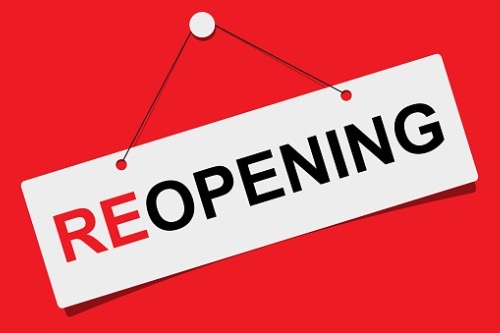Getting up and running post-Covid-19 closedown

Now the Government has provided some information about the process of easing lockdown measures, businesses will be turning their minds to getting back up and running. From safety checks to supply chain disruption and security measure to staffing, getting back to business is more than just switching the lights back on. In this article we help you figure out where to start.
First and foremost, as you prepare to re-open sites and buildings to get operations back up to speed, ensure you continue to comply with any continuing Government rules and guidance for personnel ‘distancing’, PPE usage and good hygiene.
Before you begin operations
- Check the grounds around the site in case intruders have left waste or other unwanted debris around, and check for signs of attempted intrusion or actual break-ins. Organise to clear any debris and to repair any signs of damage.
- Check that fencing and locked gates are still in good condition and not showing evidence of damage or collapse.
- Check security alarms and fire alarms are still in service and all components are fully operational without faults – check that remote diallers or remote monitoring services are still operational.
- Conduct your weekly/monthly fire and security alarm tests shortly after re-opening the building to prove the systems are working as would be expected.
- Ensure emergency lighting, fire exits and fire extinguishers are operational and kept clear.
- Check CCTV is still operational - review the security tapes when you have time available to check whether any unwanted activity has occurred outside your premises or any intrusion is evident onto your site during the closedown.
- Check that sprinkler systems, fire pumps, gaseous or water mist fire suppression systems etc. are in service or, if they were decommissioned during the shutdown period, organise for your regular contractor to attend site to get them back in service before operations start-up.
- Inspect buildings, roofs, doors, windows for signs of leakage or weather damage or attempted intrusion damage – get repairs organised as soon as possible.
- Check gutters and drains in the early days of re-occupation to ensure they are not blocked by leaves, twigs, grass, weeds, dead birds or animals or wind-blown debris – get them cleared and flushed through as soon as practical.
- Reassess emergency response procedures and teams to ensure adequate coverage of key roles by available personnel. If key roles can’t be filled, be cautious about starting up hazardous processes until your emergency response capability is up to scratch.
- Check availability of staff for work and assess whether they are healthy enough to work. Ensure that you have sufficient workforce to safely run operations.
As you prepare to re-start operations
- In parallel with start-up of operations, check with your suppliers and customers to determine to what extent you will be able to re-establish your inwards and outwards supply chains.
- If there are likely to be shortfalls of raw materials, begin the process of seeking alternatives whilst simultaneously planning production or service delivery within the limitations you expect to face.
- If key customers are no longer operating or have not yet started taking product or services, plan production or service delivery to match expectations.
- Stockpiling of raw materials, work-in-progress or finished goods needs to be done with caution - ensure safety limits are not exceeded, sprinkler rules are complied with and fire exit routes are kept clear.
As start-up begins
- Only permit qualified personnel or contractors to re-start boilers, steam generators, power generators, compressors, fume incinerators, fryers, ovens, other heated equipment and any pumping or processing equipment for hazardous/flammable materials. If qualified personnel are not available, don’t deploy untrained staff to attempt to do the work.
- Inspect process/production equipment before re-connecting power, gas, water, steam, air, oil and other services. Get any signs of weakness, degradation, seepage, leakage or damage repaired before attempting start-up.
- Ensure battery chargers, floor scrubbers, fork-lift trucks, space heaters and similar equipment is fully inspected and checked to be in good condition before being put back in service.
- If new contractors need to be engaged because your regular ones are not available, ensure that their qualifications and competency is checked along with having valid Public Liability insurances in place. Don’t skip on induction and site hazard awareness training and ensure they fully comply with permit to work rules, especially Hot Work Permit controls.
- Follow manufacturers recommended procedures for start-up of machinery – plan to ramp up process or service capacity gradually over a period of hours or days to ensure everything is working correctly and safely.
- If resources are limited, consider prioritising re-start of production lines for your most critical and most profitable products or services.
- If one portion of your process is your people bottleneck, such as manual packing in a manufacturing environment, install Perspex (or similar) barriers between employees to maintain ‘distancing’ whilst achieving good density. If you extend your work areas into adjacent spaces, ensure you risk assess the new area and new equipment to ensure employees continue to have a safe working environment.
- If temporary workstations need to be set-up to enable sufficient distancing between staff whilst working, be cautious about overuse of extension power leads. Don’t be tempted to daisy chain extension leads and make sure you don’t overload extension leads or power sockets with the equipment you plug into them. Get an electrician in to install additional power sockets with correctly sized cables and safely routed cable-runs so that trip hazards are minimised too.
- Don’t deploy unqualified staff to pick up tasks they are not familiar with until they have had suitable training. If you have to engage new permanent or temporary employees, ensure they receive appropriate training on their responsibilities, their tasks and the emergency procedures before they start their work.
- Remind employees and contractors of their social responsibility to others and if they show signs of illness or have been on contact with others that are unwell, they should not return to work immediately but do so in line with Government guidelines.
Once you are up and running
- If your resources continue to be limited, rotate personnel to progressively bring staff back on board, supported with appropriate refresher training – this should enable you to re-engage a larger portion of your employees and get them ready for full operations in the near future as the wider economy opens up.
- Review your contingency plans and business continuity plans to determine what can be enhanced based on what worked and what didn’t leading up to and during the crisis period; also, take on board any new learnings from the Covid-19 disruption from your company’s experiences and from your business sector in general.
- Monitor Government announcements regarding the Covid-19 rules and guidelines - only relax precautionary measures to the extent that you can continue to achieve on-going compliance.
For more information about QBE’s Risk Solutions team and guidance click here
Authored by QBE
About QBE
QBE European Operations is part of QBE Insurance Group, one of the world’s leading international insurers and reinsurers and Standard & Poor’s A+ rated. Listed on the Australian Securities Exchange, QBE’s gross written premium for the year ended 31 December 2018 was US$13.7 billion.
As a business insurance specialist, QBE European Operations offers a range of insurance products from the standard suite of property, casualty and motor to the specialist financial lines, marine and energy. All are tailored to the individual needs of our small, medium and large client base.
We understand the crucial role that effective risk management plays in all organisations and work hard to understand our clients’ businesses so that we offer insurance solutions that meet their needs – from complex programmes to simpler e-trading solutions – and support them in minimising their risk exposures. Our expert risk management and rehabilitation practitioners focus on helping clients improve their risk management so that they may benefit from a reduction in claims frequency and costs.

